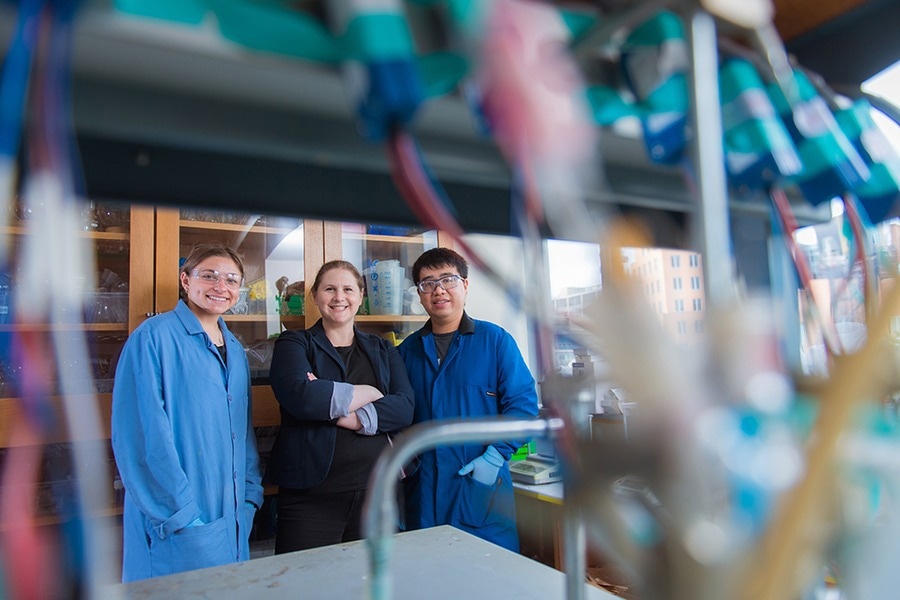Transitioning from high to low carbon dependency is one of the key drivers motivating researchers to find a solution that can address the current Dioxide (CO2) crisis.

Image Credit: Gretchen Ertl/MIT
The issue is that CO2 is one of the main contributors to climate change and is emitted as a result of human activities, most notably as an industrial by-product. Thus, developing CO2 reduction strategies and ways to ‘upconvert’ this greenhouse gas into a useful product, rather than a detrimental product, is something researchers at MIT are trying to address.
However, finding materials and ways to convert CO2 into a useful product is a highly complex task due to the high stability of the molecules, which makes conversion difficult. Furthermore, methods that have been developed tend not to be very cost- or energy-efficient.
However, rather than being deterred by this fact, the Raymond (1921) and Helen St. Laurent Career Development Professor of Chemical Engineering at MIT, Ariel Furst, set out to chart a new course – taking inspiration from a DNA-based approach, details of which have been published in a working paper in Energy Futures, the magazine of the MIT Energy Initiative
DNA-linked Catalysts
Provided with funding from the MIT Energy Initiative Seed Fund, Furst and her team saw potential in using DNA in their method.
“DNA has these really cool physical properties as a biomaterial that people don’t often think about,” explains Furst.
DNA can be used as a molecular Velcro that can stick things together with very high precision.
Ariel Furst, Professor of Chemical Engineering, MIT
Firstly, the team addressed the early challenge which is converting CO2 to carbon monoxide (CO). Producing CO from CO2 molecules requires high energy inputs to induce the desired reaction in the CO2 molecules, and what is left over often only contains small amounts of CO.
By introducing an electrocatalyst, the team was able to improve the rate of the reaction without consuming the materials.
Typically the catalyst would be suspended in a water-based solution in which the dissolved CO2 will be converted into CO once a voltage has been applied via an electrode submerged into the aqueous solution.
However, the catalyst and CO2 must come together on the electrode’s surface for an effective reaction.
You have to both wait for the diffusion of CO2 to the catalyst and for the catalyst to reach the electrode before the reaction can occur.
Ariel Furst, Professor of Chemical Engineering, MIT
As a result, researchers worldwide have been exploring different methods of “immobilizing” the catalyst on the electrode.
Inspired by biological porphyrins and combining them with the specificity of DNA hybridization, Furst and her team were able to develop an improved electrocatalyst platform for CO2 reduction, which included using DNA to immobilize the catalysts for CO2 conversion.
DNA Hybridization
The well-known image of a NA structure is the double-helix which is formed when strands of DNA connect with one another. Hydrogen bonds bring these complementary strands together, which is what the researchers based their technique on.
A single strand of DNA is attached to the electrode while a complementary strand is attached to the catalyst submerged in the aqueous solution. These two strands then hybridize when they are brought together; hydrogen bonds form the connection between the properly paired bases.
The DNA strands fix the catalyst firmly to the electrode, but the method is special because the two strands can also be uncoupled through a heating process.
“The connection is stable, but if we heat it up, we can remove the secondary strand that has the catalyst on it,” says Furst.
So we can de-hybridize it. That allows us to recycle our electrode surfaces – without having to disassemble the device or do any harsh chemical steps.
Ariel Furst, Professor of Chemical Engineering, MIT
Furst and her team were also able to demonstrate several times that immobilizing the catalyst was able to enhance the rate of CO2 to CO conversion. Having efficiently converted CO2 successfully, the team also reported that they were able to control the mix of products with increased selectivity.
The team hopes to scale this method up and develop complementary machine learning techniques to develop electrocatalytic systems to improve CO2 reduction strategies for a wide range of applications.
References and Further Reading
Fan, G. et al. (2022) DNA-based immobilization for improved electrochemical carbon dioxide reduction. ChemRxiv. [Online] Available at: https://chemrxiv.org/engage/chemrxiv/article-details/6285c04f59f0d67921958bd1. This content is a preprint and has not been peer-reviewed.
Stauffer, N., (2022) Turning carbon dioxide into valuable products. [online] Available at: https://news.mit.edu/2022/turning-carbon-dioxide-valuable-products-0907.
Disclaimer: The views expressed here are those of the author expressed in their private capacity and do not necessarily represent the views of AZoM.com Limited T/A AZoNetwork the owner and operator of this website. This disclaimer forms part of the Terms and conditions of use of this website.